This story originally aired July 17, 2017. The state just awarded the company $400,000.

More than a third of the food produced in the U.S. ends up in landfills every year; a result of overproduction to meet the grocery industry's need to keep stores fully stocked. If customers don’t find what they’re looking for, they’ll go elsewhere.
The only way to make sure you have enough for those customers is to have too much on hand. Whatever isn’t sold is often sent to the dump by grocers and food distributors.
Dan Lewis and Patrick Bultema saw this as an opportunity — and FoodMaven was born. It’s a for-profit business that distributes the oversupply of food to restaurants, school cafeterias, and other institutional kitchens at half price.
As Bultema sees it, everyone wins. For his suppliers, the overstock becomes revenue “they were going to lose, that they were going to pay to dispose of. And for our buyers, it’s a great value.”
Bultema and Lewis started the company together two years ago while working with a nonprofit food rescue organization. They were shocked by all the waste they saw. Standing by a dumpster near a Colorado Springs big box store, Dan Lewis also recalls another piece for their food waste experience: A summer spent after college salvaging food.
You know, dumpster diving.
“Looks like we’ve got some broccoli, and apples, some peppers, a lot of leafy greens we might not be able to use, but could definitely make a good stir fry,” he says from inside the bin.
Filling a brown paper grocery sack, Lewis estimates a bag of produce like this would cost up to $50. It was in dumpsters like this that he began to see a much larger problem in the food system.
“This is not bad food,” he says. “It didn’t meet some type of cut or somebody’s standard, or it’s just oversupplied and ended up in this bin.”
That’s just a tiny fraction of the 133 billion tons of food that gets dumped into landfills every year. That’s according to a 2014 U.S. Department of Agriculture report that finds 35 to 40 percent of all the food produced every year gets thrown away.
“The truth of the matter is that it’s perfectly good food that’s just getting lost in the system and tragically ends up as waste, but really doesn’t need to be,” says Lewis’ partner, Patrick Bultema.
Their company receives the oversupply food on commission. A percentage of anything sold goes back to the original producer. The goal is to keep all of it out of the landfill.
The way it works is pretty simple: When a grocery store or a distributor has an oversupply, FoodMaven sends trucks to pick it up. They warehouse it, inventory it, and upload the inventory to a website where restaurant owners or institutional kitchens can place their orders.
Nina Lee, owner of the 503 WEST restaurant in downtown Colorado Springs, regularly places orders for organic chicken breasts from FoodMaven. Her place, like many restaurants, has limited distributors to choose from. That’s why she welcomes the variety and prices FoodMaven offers.
“It was, by far, the best deal,” she says.
Not everyone’s convinced that FoodMaven’s business model will create healthy competition in the market or address the oversupply problem. Count independent Colorado Springs rancher, meat processor and food distributor Mike Callicrate as a skeptic.
“Gimme something for free and let me sell it at half its former value… No one makes that kind of margin in the food business,” he says.
An advocate for local food, Callicrate wants the food system to move toward a model of production and distribution that puts more money into the hands of farmers and ranchers. He doesn’t see the FoodMaven model as addressing the problem, but rather a way to profit from the situation.
Others like Doug Wiley, president of the Arkansas Valley Organic Growers co-op and a farmer and rancher himself, are taking a wait and see approach.
Wiley says oversupply is a big problem for small ranchers and growers, too. He hopes that Lewis and Bultema’s business might open new markets.
“The way I think of it is that it’s another outlet that I could possibly utilize,” he says. “You know, I’ve been just giving it away.”
FoodMaven hopes to go national in the next five years. The next step is to test their business model in a major market, like Denver, where they’re scheduled to open in the summer.








